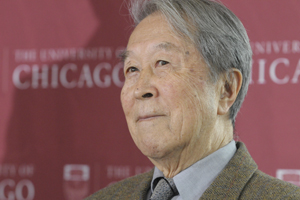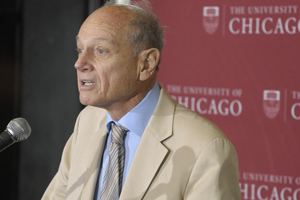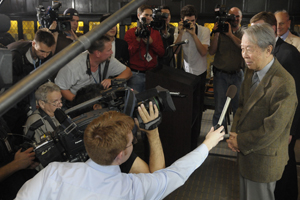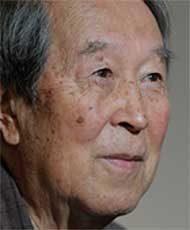Nambu shares 2008 Nobel Prize in Physics
Physicist cited for discovering mechanism in subatomic physics
 Photos by Lloyd DeGrane Professor Emeritus Yoichiro Nambu, a 2008 Nobel Prize in Physics recipient, addresses reporters and photographers during a Tuesday, Oct. 7 news conference in the McCormick Lounge. Nambu explains his research and the work for which he won the prestigious prize: the discovery of spontaneous symmetry-breaking and its application to particle physics. | |
 Yoichiro Nambu, the Harry Pratt Judson Distinguished Service Professor Emeritus in Physics and the Enrico Fermi Institute, addresses questions from the local media. James Cronin, University Professor Emeritus in Physics, speaks about his colleague Nambuís research at the news conference held Tuesday, Oct. 7. Cronin shared the 1980 Nobel Prize in Physics. | |
 | |
 | |
Yoichiro Nambu, the Harry Pratt Judson Distinguished Service Professor Emeritus in Physics and the Enrico Fermi Institute, and one of the leading figures in the development of modern particle physics, on Tuesday was awarded the 2008 Nobel Prize in Physics.
In a citation posted after the award was announced shortly before 5:30 a.m., the Nobel Foundation credited Nambu with “the discovery of the mechanism of spontaneous broken symmetry in subatomic physics.”
“It is a great honor for me to be awarded the prize this year—I did not expect it this year,” Nambu said. “It is true that I’ve been told I had been on the list for many, many years—maybe 30 years. I did not expect it in any way this particular time and, I must say, I was very surprised when I got the news.”
President Zimmer said Nambu’s work embodies the best traditions of Chicago scholarship, noting that Nambu is the 82nd person connected with the University as a faculty member, student or researcher to have received a Nobel Prize, including 28 Nobel Prizes in Physics.
“Professor Nambu really represents what it is we aspire to—the highest level of achievement that we aspire to. This is an institution that, from its beginning, was founded on the basis of rigorous inquiry. It has been viewed by many as the most serious and intense academic institution in the country, if not the world,” Zimmer said.
“The environment that is created here, and the intensity that the faculty feel about their research and in their interaction with their colleagues, really is very distinctive,” Zimmer said. “It is what fosters the work of so many of our faculty, and it is the environment that Professor Nambu has worked in and contributed to for so many years.”
 Yoichiro Nambu | The University community is invited to attend a reception at 4 p.m. Friday, Oct. 10 to honor Yoichiro Nambu and celebrate his Nobel Prize in Physics. The event will be held at the Ellen and Melvin Gordon Center for Integrative Science at 57th Street and Drexel Avenue. For more information, visit http://www.uchicago.edu/rsvp/nambu/. | ||
Nambu, 87, shares this year’s prize with Makoto Kobayashi of the High Energy Accelerator Research Organization (KEK) in Tsukuba, Japan, and Toshihide Maskawa of Kyoto University in Kyoto, Japan.
“I know these people, and I have always appreciated their work very much, so I am very happy that I share the Nobel Prize with them,” said Nambu, who has been a scholar at the University since 1954.
Provost Thomas Rosenbaum, the John T. Wilson Distinguished Service Professor in Physics, said that Nambu’s work cut a wide swath across the world of physics.
“Nambu’s work is emblematic of what we try to accomplish here at the University of Chicago: a genuinely great scholar asking fundamental questions that then have impact across the discipline and across the disciplines,” Rosenbaum said.
“What Nambu has done has, in fact, had implications, all the way from the structure of the early universe to the behavior of magnetic material,” Rosenbaum added. “In addition—and this is not a criterion for winning the Nobel Prize—I can testify first hand that Nambu is a wonderful, modest man and a generous colleague.”
Nambu’s theories form an essential cornerstone of what physicists call the Standard Model, which explains in a unified way three of the four fundamental forces of nature: strong, weak and electromagnetic.
Nobel laureate James Cronin, University Professor Emeritus in Physics, said, “It has been clear for so many years that of all the people who have won the Nobel Prize, there has been one missing, and that is Yoichiro Nambu.”
“Nambu was so far ahead of his time that it maybe was not completely realized the importance of his contributions, which are the cornerstone of the standard model of particle physics, which unites the strong interactions, the electromagnetic interactions and the weak interactions all in a clear, understandable whole,” said Cronin.
Nambu was born in Tokyo in 1921. He said he developed his interest in science in high school when his father showed him science magazines. In college, one of his professors was Hideki Yukawa, one of the early figures in particle physics.
“I liked physics because it was a way of studying fundamental problems in natural science,” he said.
He received his B.S. in 1942 from the University of Tokyo, and was then drafted into the Japanese military, where he worked at a radar laboratory. After the war, he studied with the famous Japanese physicist Sin-ichiro Tomonaga, receiving his D.Sc. in 1952 from the University of Tokyo.
Tomonaga recommended that Nambu study with J. Robert Oppenheimer at the Institute for Advanced Study in Princeton, where he went in 1952.
“The scientists were very warm to me,” Nambu recalled. “Oppenheimer was brilliant, but everyone was a little afraid of him.”
He joined the Chicago faculty as a Research Associate in 1954 and became Associate Professor in 1956 and Professor in 1958.
Nambu found the concept of spontaneous symmetry breaking, or SSB, while studying superconductivity in the early 1960s. He said that it took him two years to determine that SSB contributes to the explanation of how superconductivity works, but that once he developed the theory, he quickly turned it around and applied it to particle physics.
“Physicists believed that fundamental models of physics should be simple and elegant with symmetry built into it,” said Nambu. “Nevertheless, when it is realized in nature, some of the symmetries come out to be broken and that is a mechanism we have been seeing ever since.”
He was named the Harry Pratt Judson Distinguished Service Professor in 1977 and served as Chairman of Physics from 1974 to 1977.
Nambu became a U.S. citizen in 1970. He and wife Chieko Nambu have a son, John Juichi Nambu.
Though he became a professor emeritus in 1991, Nambu noted Tuesday how his theories are being tested today at some of the world’s leading facilities, including the new particle accelerator at CERN in Geneva, where scientists hope to discover occurrences of symmetry breaking.
“Recent experiments or advances in cosmology can satisfy that people now can talk about the origins of the universe and see how the universe measures with that one which we know today,” Nambu said. “Symmetry breaking is one of the fundamental ideas, which can be applied to many, many branches of physics.”
Nambu’s current research centers on why different quarks have different masses—a consequence, physicists believe, of SSB.
“Why quarks have different masses is one of the last unsolved puzzles of the Standard Model,” he said.
And how does Nambu go about solving a problem like that? He once answered, laughing, “I think about it all the time.” He said Tuesday he hopes to keep thinking about it as long as he lives.
His previous honors include the Wolf Prize in Physics, the National Medal of Science, the Dannie Heineman Prize for Mathematical Physics, the J. Robert Oppenheimer Prize and the Order of Culture from the government of Japan.
![[Chronicle]](/images/sidebar_header_oct06.gif)